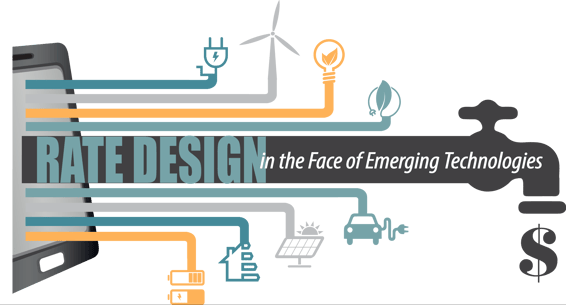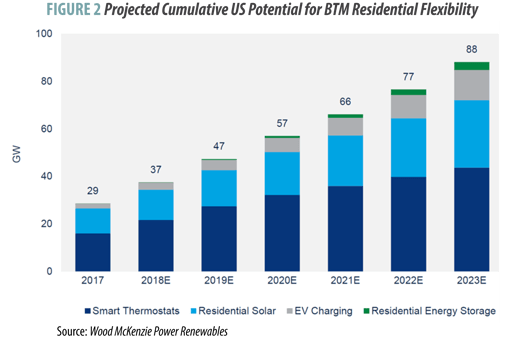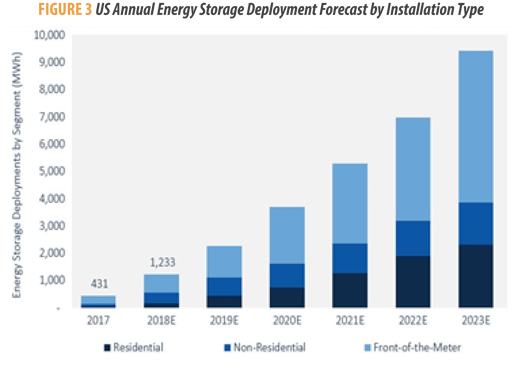- Home
- Services
- Hi-Line Engineering
- About
- Careers
- Contact
- Requests For Proposals
Rate Design in the Face of Emerging Technologies
by GDS Associates, Inc | May 14, 2020 | News , Newsletter - TransActions
 Ten years ago, if someone told a room full of electric utility personnel that energy sales and the economy were highly correlated and that sales would increase year after year, most people would nod their head in agreement. With steady and predictable energy sales, recovery of fixed costs based on these sales was generally not subject to significant risk. Even though the economy has been strong over the past ten years, this correlation no longer holds true and residential consumption has been flat or decreasing every year. New technology has resulted in higher energy efficiency in the everyday products used by customers and some consumers have also turned to using alternatives such as rooftop solar panels and are generating their own energy, impacting sales even further. One major concern is with sales unable to recover costs like they once did, externalities like fluctuations in the weather, causing either much higher consumption due to excessive AC or much lower consumption due to mild weather, have a much greater impact on utility margins. Finding unique and adaptive solutions is essential to this new era of electric sales because traditional methods don’t always recover fixed costs in a reliable fashion.
Ten years ago, if someone told a room full of electric utility personnel that energy sales and the economy were highly correlated and that sales would increase year after year, most people would nod their head in agreement. With steady and predictable energy sales, recovery of fixed costs based on these sales was generally not subject to significant risk. Even though the economy has been strong over the past ten years, this correlation no longer holds true and residential consumption has been flat or decreasing every year. New technology has resulted in higher energy efficiency in the everyday products used by customers and some consumers have also turned to using alternatives such as rooftop solar panels and are generating their own energy, impacting sales even further. One major concern is with sales unable to recover costs like they once did, externalities like fluctuations in the weather, causing either much higher consumption due to excessive AC or much lower consumption due to mild weather, have a much greater impact on utility margins. Finding unique and adaptive solutions is essential to this new era of electric sales because traditional methods don’t always recover fixed costs in a reliable fashion.
 It has been a standard practice to recover fixed costs from residential customers through a two-part rate design consisting of a low fixed customer charge and an energy charge that recovered the remaining portion of the utility’s fixed costs. Now, with energy sales across the residential class either flattening or in some markets declining, the traditional rate design is not recovering fixed costs as it once did. One of the first lines of defense for utilities to combat declining sales trends is to raise the customer charge. Although a good alternative, raising the customer charge may not always be the best solution, and utilities can look to advanced technology to help. Real time interval load data from AMI helps provide the information that enables utilities to create dynamic rate designs that can result in improved recovery of fixed costs. But new rate alternatives and strategies have to be developed and implemented to complement existing ones. Going forward, one of the main concerns for every utility will be understanding how emerging technologies will impact energy consumption patterns and how that changed consumption will further impact rate design. With newer technologies becoming more common and available in all areas of the country, investor owned utilities, municipalities,and cooperatives are all having to find ways to adjust with improved product efficiency and changing consumption patterns. Potential widespread use of smart devices, EVs, advanced batteries should spur utilities to consider alternative rate designs that may better recover costs.
It has been a standard practice to recover fixed costs from residential customers through a two-part rate design consisting of a low fixed customer charge and an energy charge that recovered the remaining portion of the utility’s fixed costs. Now, with energy sales across the residential class either flattening or in some markets declining, the traditional rate design is not recovering fixed costs as it once did. One of the first lines of defense for utilities to combat declining sales trends is to raise the customer charge. Although a good alternative, raising the customer charge may not always be the best solution, and utilities can look to advanced technology to help. Real time interval load data from AMI helps provide the information that enables utilities to create dynamic rate designs that can result in improved recovery of fixed costs. But new rate alternatives and strategies have to be developed and implemented to complement existing ones. Going forward, one of the main concerns for every utility will be understanding how emerging technologies will impact energy consumption patterns and how that changed consumption will further impact rate design. With newer technologies becoming more common and available in all areas of the country, investor owned utilities, municipalities,and cooperatives are all having to find ways to adjust with improved product efficiency and changing consumption patterns. Potential widespread use of smart devices, EVs, advanced batteries should spur utilities to consider alternative rate designs that may better recover costs.
SMART THERMOSTATS & OTHER SMART DEVICES
One of the leading emerging technologies in the residential market is the smart thermostat. There are varying degrees to just how smart a thermostat must be in order to garner the “smart” moniker. A true smart thermostat uses advanced algorithms to learn a person’s schedule and adjust the temperature in order to most effectively condition the home using the least amount of energy. Such true smart thermostats are becoming increasingly standard on new construction homes. A case in point is Austin, TX which requires home builders to install smart thermostats on all new homes and apartment buildings1. As building codes are changed and efficiency standards are updated, smart thermostats will continue to gain market share, similar to how more efficient alternatives to incandescent lighting such as CFL and LED bulbs did beginning a decade ago. Smart thermostats were projected to account for nearly 20 million installed units nationwide by 2020 in a report from the Northeast Energy Efficiency Partnerships published in 20192.
Other smart appliance technology is still developing, but some of the same benefits that smart thermostats supply could be achieved for dishwashers, washing machines, clothes dryers, ranges, lighting, and more. As consumers become more accustomed to the smart home and realize the benefits market share for other connected appliances is expected to grow3. All of these advancements in the Internet of Things will allow customers to understand their home’s energy use and respond to price signals from their  electric utility much more easily. A side-effect of the increasing popularity of the connected smart home that the utility needs to consider is the potential for lower energy consumption. However, innovative time-of-use (TOU) or critical peak pricing (CPP) rate designs coupled with AMI meters could encourage consumers to reduce consumption during peak hours when energy costs are their highest. The average consumer may be much more willing, or even desire to be billed on a TOU, CPP, or other dynamic pricing rate if the consumer believes their smart home can help them reduce their energy bill (see Figure 2).
electric utility much more easily. A side-effect of the increasing popularity of the connected smart home that the utility needs to consider is the potential for lower energy consumption. However, innovative time-of-use (TOU) or critical peak pricing (CPP) rate designs coupled with AMI meters could encourage consumers to reduce consumption during peak hours when energy costs are their highest. The average consumer may be much more willing, or even desire to be billed on a TOU, CPP, or other dynamic pricing rate if the consumer believes their smart home can help them reduce their energy bill (see Figure 2).
“We will not stop until every car on the road is electric,” Elon Musk proclaimed in 2014. The International Energy Agency’s latest report shows 2018 the United States had approximately 1.1 million EVs, which represents 2.4% of the total car market share. Musk’s goal still has a way to go, but with lithium batteries becoming cheaper and charging stations more prominent throughout the country, utilities in most regions of the nation are feeling the influence EVs as manufacturers have extended the mileage achieved per charge.
Electric Vehicles
Most EVs come with a standard home installed charger, but when exactly a consumer charges their vehicle has become a point of emphasis for utilities. If there were no adjustments to standard rates for EV owners and they plugged their vehicles into the charger when they arrived home, it could increase electric load during peak load conditions, which in turn would increase cost to the utility. By offering special EV/TOU rates with lower prices during off-peak hours, usually during the middle of the night, the consumer is incentivized to charge during hours that do not negatively impact the peak load. The higher energy consumption during these usually quiet “off peak” hours greatly improves a utility’s load factor, which can lead to greater fixed cost recovery. With the reduction in the peak load by the consumer and the reduction in energy bill for the consumer, the configuration of a specific time of use rates for EVs can be seen as a “win-win” for both parties.
Battery Storage Technology
Battery storage technology is a maturing field and will likely begin to impact residential rate design soon. While the current market share of retail-battery storage is far from that of smart thermostats, it is a growing segment of the market. As residential solar installations continue to grow and battery storage technology matures and costs decline, the  benefits of coupling battery storage with a solar installation will begin to outweigh the costs of installation and maintenance (see Figure 3). Forward thinking utilities should begin to gather data and consider how increasing consumer adoption of retail-scale batteries combined with solar PV panels will affect cost recovery. Retail rates must be designed with consideration for a variety of issues a battery-solar panel combination could pose, including changes in energy consumption patterns, decreased energy purchases, purchases of excess customer energy, or the redundancy of certain traditional demand response (DR) programs. One significant benefit of retail batteries is the potential for the batteries to be deployed as a DR measure; by charging a battery during off-peak hours and discharging during on-peak hours a utility can easily shift costs from higher on-peak periods to lower off-peak periods. These savings can be achieved without inconveniencing residential customers, such as shutting off their AC systems, can easily increase the amount of load control available to a utility. When combined with rooftop solar, a retail battery will allow a customer to store solar power for use during peak periods, reducing consumption from the utility and lowering the utility’s peak demand requirements. If desired, a utility can bill customers under rates that require the customer to allow the utility to discharge the battery a certain number of hours per year, using the battery as a de facto peak shaving DR measure. This type of rate design would still allow the retail customer to benefit from their solar/battery installation, while also allowing the utility to realize extra benefit during critical peak hours.
benefits of coupling battery storage with a solar installation will begin to outweigh the costs of installation and maintenance (see Figure 3). Forward thinking utilities should begin to gather data and consider how increasing consumer adoption of retail-scale batteries combined with solar PV panels will affect cost recovery. Retail rates must be designed with consideration for a variety of issues a battery-solar panel combination could pose, including changes in energy consumption patterns, decreased energy purchases, purchases of excess customer energy, or the redundancy of certain traditional demand response (DR) programs. One significant benefit of retail batteries is the potential for the batteries to be deployed as a DR measure; by charging a battery during off-peak hours and discharging during on-peak hours a utility can easily shift costs from higher on-peak periods to lower off-peak periods. These savings can be achieved without inconveniencing residential customers, such as shutting off their AC systems, can easily increase the amount of load control available to a utility. When combined with rooftop solar, a retail battery will allow a customer to store solar power for use during peak periods, reducing consumption from the utility and lowering the utility’s peak demand requirements. If desired, a utility can bill customers under rates that require the customer to allow the utility to discharge the battery a certain number of hours per year, using the battery as a de facto peak shaving DR measure. This type of rate design would still allow the retail customer to benefit from their solar/battery installation, while also allowing the utility to realize extra benefit during critical peak hours.
Conclusion
The energy landscape is continually changing and evolving in countless ways. Smart thermostats and devices, EVs, and batteries are just a few of the emerging technologies primed to alter the market in the near future. The typical two-part residential rate design may not effectively recover fixed costs as customer energy usage patterns change. More innovative rate designs could be the answer to ensuring better cost recovery in a changing landscape so that customers can take advantage of emerging technologies and more effectively manage consumption and their bill. In doing so, utilities could benefit in a number of ways, including better cost recovery, reduced peak loads, increased consumption during lower energy cost times, and of course happier customers.
References 1 City of Austin, TX, Ordinance No. 20160623-099 2 Northeast Energy Efficiency Partnerships, The Smart Home: Driving Residential Decarbonization, March 2019 3 McKinsey & Company, There’s No Place Like [A Connected] Home: Perspectives on the connected consumer in a world of smart devices
For more information or to comment on this article, please contact:
 Jordan Janflone, Analyst | CONTACT
Jordan Janflone, Analyst | CONTACT
GDS Associates, Inc. – Marietta, GA
770-799-2345 or jordan.janflone@gdsassociates.com
 Sam Lister, Rate & Economic Analyst | CONTACT
Sam Lister, Rate & Economic Analyst | CONTACT
GDS Associates, Inc. – Marietta, GA
770-799-2355 or sam.lister@gdsassociates.com
GET OUR NEWSLETTER
RECENT POSTS
- Exploring the 2026-2028 Reliability Standards Development Plan
- Blackstart Resource Availability During Extreme Cold Weather Conditions
- DOE Pushes FERC to Accelerate Large Load Grid Access
- Building a Cyber-Aware Workforce in the Utility Sector
- Cyber Resiliency in the Utility Sector: Lessons from the Field
Archives
- December 2015 (8)
- June 2025 (7)
- January 2016 (6)
- July 2016 (6)
- March 2021 (6)
- May 2022 (6)
- August 2020 (5)
- March 2015 (4)
- January 2019 (4)
- June 2019 (4)
- August 2019 (4)
- February 2020 (4)
- May 2020 (4)
- June 2020 (4)
- December 2020 (4)
- July 2021 (4)
- October 2021 (4)
- April 2024 (4)
- December 2024 (4)
- May 2025 (4)
- April 2015 (3)
- August 2016 (3)
- February 2017 (3)
- July 2017 (3)
- February 2018 (3)
- February 2019 (3)
- November 2019 (3)
- March 2020 (3)
- April 2020 (3)
- September 2021 (3)
- December 2021 (3)
- August 2022 (3)
- December 2022 (3)
- April 2023 (3)
- July 2023 (3)
- December 2023 (3)
- September 2024 (3)
- October 2025 (3)
- May 2014 (2)
- February 2016 (2)
- March 2016 (2)
- September 2016 (2)
- November 2016 (2)
- January 2017 (2)
- July 2018 (2)
- November 2018 (2)
- March 2019 (2)
- May 2019 (2)
- July 2020 (2)
- September 2020 (2)
- April 2021 (2)
- August 2021 (2)
- October 2024 (2)
- September 2025 (2)
- December 2025 (2)
- February 2014 (1)
- April 2014 (1)
- July 2014 (1)
- August 2014 (1)
- November 2014 (1)
- February 2015 (1)
- May 2015 (1)
- June 2015 (1)
- November 2015 (1)
- October 2016 (1)
- December 2016 (1)
- October 2018 (1)
- December 2018 (1)
- April 2019 (1)
- July 2019 (1)
- September 2019 (1)
- October 2020 (1)
- November 2020 (1)
- February 2021 (1)
- April 2022 (1)
- July 2022 (1)
- October 2022 (1)
- August 2023 (1)
- October 2023 (1)
- July 2025 (1)
- November 2025 (1)
Categories
- Newsletter - TransActions (85)
- News (78)
- Employee Spotlight (35)
- Energy Use & Efficiency (28)
- Energy, Reliability, and Security (16)
- Other Specialized Services (11)
- Environment & Safety (10)
- Power Supply (8)
- Transmission (8)
- NERC (7)
- Utility Rates (7)
- Cyber Security (5)
- Energy Supply (4)
- Hi-Line: Utility Distribution Services (4)
- Battery Energy Storage (3)
- Uncategorized (2)
- Agriculture (1)
- Hi-Line: Seminars & Testing (1)